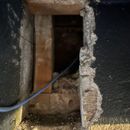Rim joist sealing in 1929 house
We’re preparing to replace the gas furnace in our 1929 southern Ontario (CZ 6) home with a ccASHP before winter. We have sealed and insulated the attic and replaced almost all of the windows with high performance triple-paned models.
The exterior construction of the house is wide plank sheathing covered by brick with recessed mortar (seemingly popular around here at that time). There is parging on the exterior of the foundation, which extends about 2 1/2 feet above grade. The interior is almost all plaster and lath with no wall insulation. (The exception is the kitchen, which was remodeled in 2019.)
We are assessing the rim joist area of the basement as a potential air sealing win. Fully finishing the basement, and thus insulating the whole thing is not in the cards at this time.
The basement appears to be brick wall construction, covered on the interior with cement. This extends up between the joists.
However, in several places, holes have been made in the cement between the joists to run wires up inside the walls, dryer duct outside, etc. Looking inside, I see the cement covering the brick, with a cavity and sheathing boards beyond (see photo). In some cases, the workers who made the holes have shoved some fiberglass insulation into the cavities.
We’ve had people in to estimate air sealing and insulating the rim joist area. Multiple companies have suggested that we spray foam into the cavities made by the holes in the cement, and then spray foam over the interior cement between the joists. In the latter case, this means spray foam on the interior of the basement wall, which would seep down onto the wall below the joists. They variously suggest painting the foam with fire retardant paint or putting up roxul over the foam. We are not keen on this solution, for aesthetic reasons. (While the basement is not a showplace by any stretch, we do use it for laundry and exercise and we don’t want it to look even worse than it does.)
I am wondering if sealing off those holes (there are 8 of them) between the joists and then caulking around the joists will buy us much in terms of the stack effect, or air sealing in general. Any air that gets in at the exterior will still have a path up inside the walls. But will keeping it out of the living space in the basement be helpful?
If this seems worth doing, what would be the best way to work around the wires and such that are running up through those openings? Also, would it be worth shoving some Roxul into the cavities before sealing off the interior?
GBA Detail Library
A collection of one thousand construction details organized by climate and house part










Replies